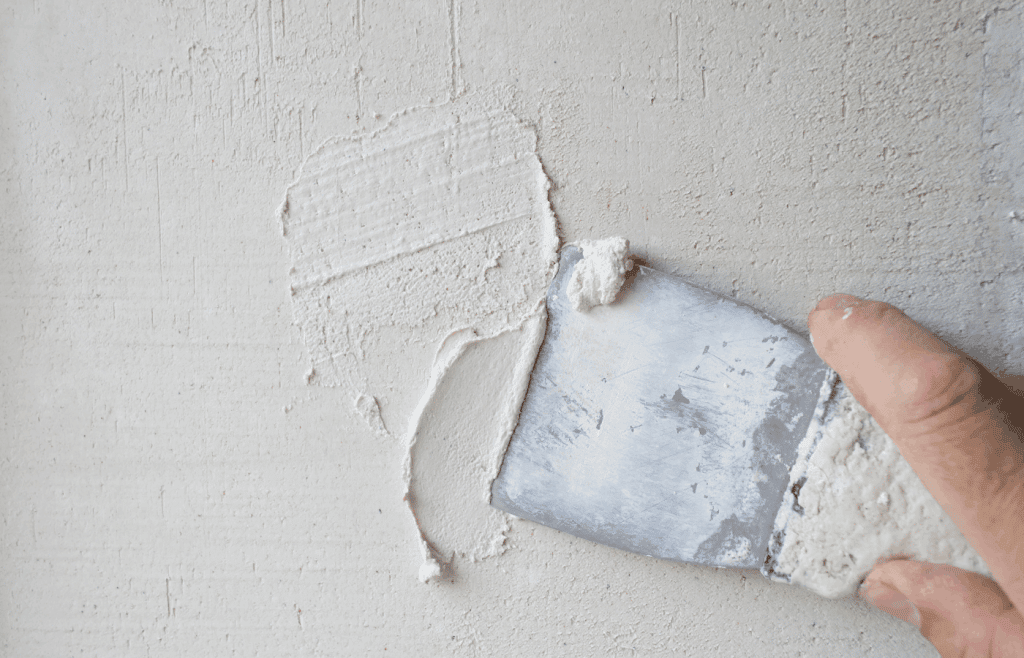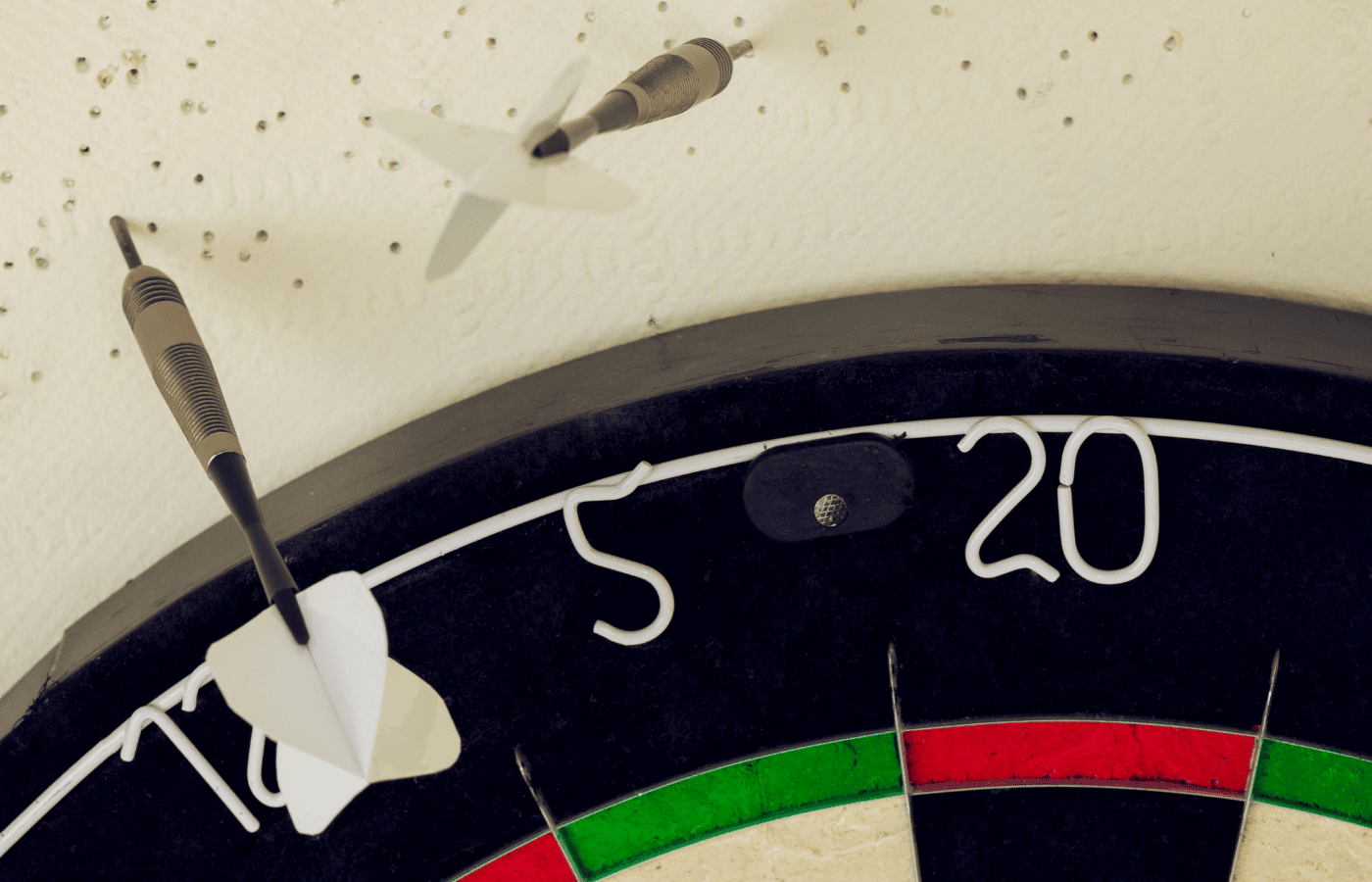When you are playing darts in your home, you can expect to have a few misses and your dart will end up directly in your wall or your door. Maybe you’ve just moved into a place that the previous occupants left several dart holes in.
There are several ways that you can fix dart holes. Wall putty and wood putty are two of the easiest and most effective ways to cover and repair holes from stray darts.
Much like other DIY projects, there are quick solutions to fix your problem for the time-being, and there are detailed procedures for fixing your wall. Depending on what you are looking to do and the coverage you are trying to get, there are procedures that will suit your needs.
Repairing Dart Holes in Walls
Dart holes in walls are the most common types of holes since most dartboards are hung up in a bedroom, garage, or game room.
Using Wall Putty
There are a few things you will need to get in order to complete the project with wall putty. This includes a container of putty, a spatula, a small wall paint brush, a plastic knife, a towel, a sanding brick or paper, paint, and water.
We recommend using a small hole repair kit like this one by 3M. It’s both durable and easy to use and can last you awhile if you ever need to repair future holes.
The first thing you need to do is pick out the correct paint color. This will be easiest if you can get a small paint chip off the wall. You can then take it to a hardware store so they can match the color for you.
You also need to make sure the finish of the paint is the same as your wall, and the hardware store should be able to help you pick the right finish, too.
Next, you will need to work together the putty. Stir the putty together until it is slightly stiff, but not too thick. You will only need a small amount at a time, so to get some putty use the corner of the spatula.

To fill the hole in the wall, take the putty you have on your spatula and press it against the wall where the hole is. Depending on the size of the hole, you might need to add more putty to fill it in completely. Make sure you smooth out the putty as best you can with the spatula.
When the putty has completely dried, use theprovided sandpaper to sand it down so it is flat against the wall. If your wall is textured, this part is not as important.
The next part will be painting the wall. Use the plastic knife or wooden stick that comes with the paint to mix it together. You can test out a small patch of the paint before you begin to make sure it is actually the same color and finish of your current wall.
Wood Putty for Doors
If you are dealing with holes in your door from darts, there is a solution to that as well. Similar to wall putty, wood putty can fill the holes in your door to make it look more presentable. Wood putty is used not only for fixing holes, but also scratches, chips, and gouges, so you can treat your hole door at the same time.
This wood putty comes in various colors and is both high quality and easy to use.
The tools and materials you need to filling holes in your door include sandpaper, a shop vacuum, wood putty, tack cloth, a putty knife, polyurethane sealer, paint, and wood stain.
The first step, of course, is taking the door off of the hinges to make it easier to work with. After your door is down, you need to make sure it is ready and prepped for you to work on it.
You can do this by removing any of the loose chunks or paint flakes. Sand down the rough edges, then clear away all of the dust and debris with a shop vac.
Next, apply the wood putty using the putty knife. Start at the edge of the hole and gently press the wood putty down into the hole. You can slightly overfill the hole due to the fact that the putty will shrink as it dries. Once you apply the proper amount of putty, smooth it over with the clean part of your putty knife.
Allow the putty to completely dry. The manufacturer packaging will tell you how long it recommends the putty to dry for. It could take anywhere from 15 minutes to 8 hours to fully dry.
After you have let the recommended time pass to dry, sand down the area so that it is smooth. When you run your hand over the undamaged and filled parts, there should only be a tiny difference in smoothness. In most cases, your repair will be unnoticeable.
If you are dealing with a door that has been stained, the process can be a little bit more complicated. To get the closest possible color match, it is recommended to test out on a scrap piece of wood first.
Take some of the putty and apply it to the scrap wood. Let it dry and then apply the stain over top. This will give you the right idea of how much stain you need, and if you have the right color.
How to Repair Dart Holes in Hollow Doors
If your door is hollow, the process will look a little differently. The first step is the same as a regular door, starting with taking it off the hinges. You will also need to fix up some of the rugged and loose edges with sandpaper. Dust off the area to make sure it is clean.
The next thing you will need to do is apply some nonexpanding foam insulation spray into the hole. You will want to make sure you fill the hole completely and let it dry all the way. The foam will work to create a solid base that can support the wood putty.
Remove a thin layer of the dried foam with a utility knife. You want to create a small cavity in the foam that will hold the wood putty. Once you have this set up, take some of the wood putty and apply it to the hole using a putty knife.
Make sure you slightly overfill the hole to make the filling slightly higher than the surface of the door. Give the wood putty time to dry completely.
Sand down the wood putty until the hole is flat with the surface of the door. Clean up the surface of the door with a cloth rag. Paint or stain the hole to match the rest of the door.
Ways to Protect Your Wall from Stray Darts
If you want to continue playing darts at home but you don’t want to keep filling holes all the time, there are ways that you can protect your wall from getting damaged by stray darts.
Dartboard Cabinet
One of the most effective ways of keeping your wall safe is with the use of a dartboard cabinet. While it may not provide protection for the entire wall, it will protect some of the most common places that darts will land. Dartboard cabinets are also available in different sizes, so you can pick the one that works best for your space.
Dartboard Surround
A dartboard surround is another great way to protect your wall from dart holes. It is a foam ring that sits around your dartboard and provides additional protection to your wall. The thickness of the foam you choose is important, and the best thickness if about 1-inch.
DIY Ways to Protect Your Wall
There are several ways to protect your wall that won’t even cost you any money. The first way is with a wooden board. Any type of wooden planks or salvaged wood can be of service to you here. It is also the most recommended DIY protection because it will not damage the tips of your darts.
If you have an old door lying around in your basement or your garage, this is also a great way to protect your wall from darts. You can also use old cabinet doors if you have just gone through a renovation. As long as you don’t care about damaging the door or the cabinets, this is a perfect option.
You might also want to consider cork flooring or a cork bulletin board. Cork is a very highly recommended material to use as a barrier around your dartboard. The material is not too hard, so you don’t have to worry about it damaging the tips of your darts.
It is important to make sure the material you choose is thick enough, so you don’t risk the dart hitting through to your wall. Some other options include ceiling tiles, cardboard, styrofoam, carpet, and old clothes or towels.
Materials Not to Use for Protection
While there are plenty of things you can use to protect your wall, there are also some materials you should steer clear from. These include hard materials such as any type of metal, tiles, or concrete. These would protect your wall of course, but they would destroy your dart tips.
Final Thoughts
Having tiny holes in your wall from stray darts can be really frustrating, but luckily it is pretty easy to patch the holes that are there.
With the use of wall putty or wood putty, patching up the holes should be a pretty easy task even if you aren’t the handiest around the house.
If you want to keep playing darts in your home but you don’t want to keep filling holes from darts, consider putting up some type of protection around your board to keep stray darts from hitting the wall.



